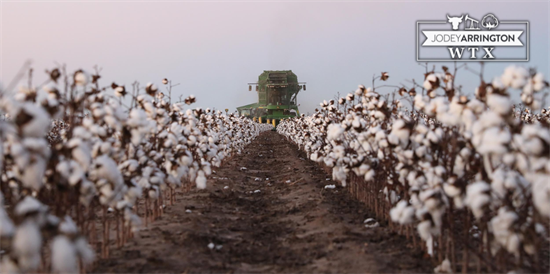Press Releases
Arrington Applauds Swift Disaster Aid Delivery for Farmers Under Trump Administration
Washington,
July 10, 2025
WASHINGTON, D.C. – Today, House Budget Chairman Jodey Arrington (TX-19) praised the Trump Administration and Secretary of Agriculture Brooke Rollins for delivering long-overdue relief to American farmers reeling from natural disasters over the past two years. "Our hard-working farmers and ranchers are the lifeblood of West Texas and backbone of our nation providing the food, fuel, and fiber needed to keep our economy strong and country secure," said Chairman Arrington. "Unfortunately, while West Texas producers faced years of record droughts, the Biden administration grossly mismanaged federal disaster relief by illegally distributing funds based on race and sex, causing payments to be significantly delayed. Thankfully, President Trump and Secretary Rollins understand the urgency of the situation and the common-sense notion that since disasters don’t discriminate, neither should the federal assistance. I am proud to fight alongside the Trump administration to swiftly deliver this desperately needed relief to Rural America." This announcement follows Secretary Rollins’ comprehensive plan to deliver the total amount of Congressionally appropriated $30 billion in disaster assistance to farmers and ranchers this year. These programs will complement the forthcoming state block grants that USDA is working with 14 different states to develop. “American farmers are no stranger to natural disasters that causes losses that leave no region or crop unscathed. Under President Trump’s leadership, USDA has worked around the clock to deliver this relief in record time,” said Secretary Rollins. “Farmers don’t have the luxury of waiting to purchase seed, fuel and fertilizer or to pay their operating note at the bank. We are taking swift action to ensure farmers will have the resources they need continue to produce the safest, most reliable, and most abundant food supply in the world.” Under the Trump Administration’s plan, the USDA is delivering $16 billion in aid through the Supplemental Disaster Relief Program (SDRP). The funding targets producers who suffered eligible crop losses in 2023 and 2024, expediting a process that historically took 13 to 19 months under the Biden Administration. The relief will roll out in two stages. Beginning July 10, eligible producers who previously received crop insurance or Noninsured Crop Disaster Assistance (NAP) will be able to apply in person at local FSA offices. Stage two—targeting shallow and uncovered losses—will follow in the fall. USDA has already delivered more than $7.8 billion through the Emergency Commodity Assistance Program (ECAP) and $1 billion in Emergency Livestock Relief Program. The SDRP funds are part of a broader $30 billion disaster aid plan authorized by Congress and championed by the Trump Administration. USDA disaster assistance information can be found on farmers.gov, including the Disaster Assistance Discovery Tool, Disaster-at-a-Glance fact sheet, Loan Assistance Tool, and the FarmRaise online FSA education hub. Payment details will be updated here weekly. For more information, contact your local USDA Service Center. Program Details: SDRP Stage 1 FSA is launching a streamlined, pre-filled application process for eligible crop, tree, and vine losses by leveraging existing Noninsured Crop Disaster Assistance Program (NAP) and Risk Management Agency (RMA) indemnified loss data. The pre-filled applications will be mailed on July 9, 2025. Eligibility Eligible losses must be the result of natural disasters occurring in calendar years 2023 and/or 2024. These disasters include wildfires, hurricanes, floods, derechos, excessive heat, tornadoes, winter storms, freeze (including a polar vortex), smoke exposure, excessive moisture, qualifying drought, and related conditions. To qualify for drought related losses, the loss must have occurred in a county rated by the U.S. Drought Monitor as having a D2 (severe drought) for eight consecutive weeks, D3 (extreme drought), or greater intensity level during the applicable calendar year. Producers in Connecticut, Hawaii, Maine, and Massachusetts will not be eligible for SDRP program payments. Instead, these states chose to cover eligible crop, tree, bush, and vine losses through separate block grants. These block grants are funded through the $220M provided for this purpose to eligible states in the American Relief Act. How to Apply To apply for SDRP, producers must submit the FSA-526, Supplemental Disaster Relief Program (SDRP) Stage 1 Application, in addition to having other forms on file with FSA. SDRP Stage 1 Payment Calculation Stage 1 payments are based on the SDRP adjusted NAP or Federal crop insurance coverage level the producer purchased for the crop. The net NAP or net federal crop insurance payments (NAP or crop insurance indemnities minus administrative fees and premiums) will be subtracted from the SDRP calculated payment amount. For Stage 1, the total SDRP payment to indemnified producers will not exceed 90% of the loss and an SDRP payment factor of 35% will be applied to all Stage 1 payments. If additional SDRP funds remain, FSA may issue a second payment. Future Insurance Coverage Requirements All producers who receive SDRP payments are required to purchase federal crop insurance or NAP coverage for the next two available crop years at the 60% coverage level or higher. Producers who fail to purchase crop insurance for the next two available crop years will be required to refund the SDRP payment, plus interest, to USDA. SDRP Stage 2 FSA will announce additional SDRP assistance for uncovered losses, including non-indemnified shallow losses and quality losses and how to apply later this fall.
### |


